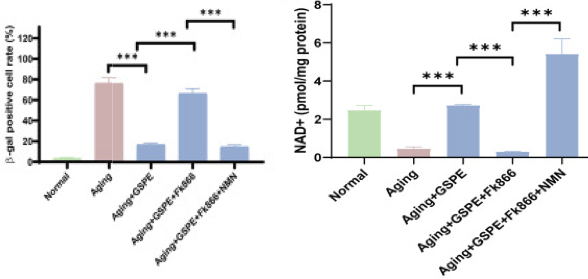Grape Seed Extract and NMN Protect Mouse Retinal Cells from Aging, Study Finds
The berry-based compound proanthocyanidin may help millions suffering from retinal disorders and protect many from blindness by boosting NAD+ levels.
Highlights
· A compound from grape seed extract called proanthocyanidin has anti-aging qualities in retinal cells.
· The grape seed proanthocyanidin extract (GSPE) works by activating the levels of an enzyme NAMPT that generates NMN, a precursor to NAD+.
Our senses enable us to experience the world, especially sight (at least for humans). But many people, more than half a billion patients worldwide, are affected by retinal degenerative disorders and blindness. These visual disorders are often driven by age-related cell senescence, which describes when cells can no longer replicate, causing disruptive changes in the retina. Understanding cell senescence in the eye can provide clues for treating retinal disease, which remains a significant problem that needs to be solved urgently. Fortunately, we may not need to look much further than some widely available fruit.
Researchers from The First Affiliated Hospital of Zhengzhou University alleviate retinal cellular senescence in aging mice using a compound extracted from grape seeds called proanthocyanidin. This Chinese research team showed that the grape seed extract works by boosting an enzyme that generates nicotinamide mononucleotide (NMN). This study, published in the Journal of Inflammation Research, highlighted the potential effects of this plant-based molecule on degenerative eye diseases.
Retinal pigment epithelium health underlies degenerative eye diseases
The pigmented layer of the retina or retinal pigment epithelium (RPE) sits just outside the neurosensory retina, where it nourishes retinal visual cells. The dysfunction of RPE is regarded as a key factor leading to the occurrence of several degenerative eye diseases, such as diabetic retinopathy (DR), retinitis pigmentosa (RP), and age-related macular degeneration (AMD). The senescence of RPE cells impairs its ability to properly secrete factors that promote the health of the sensory cells in the eye and the blood vessels that fuel them.
Grape seed extract protects cell health
Grape seed proanthocyanidin extract is extracted from whole grape seeds and exhibits antioxidant, anti-inflammatory, and anti-aging properties. This fruit-based compound has been shown to increase levels of NAMPT, which is critical to maintaining levels of the essential and age-related molecule nicotinamide adenine dinucleotide (NAD+) through NMN. The decline of NAD+ content with age is closely related to healthspan, longevity, and the occurrence of age-related degenerative diseases. In retinal degenerative diseases, the expression of NAMPT and the NAD+ content is consistent and reduced compared with the healthy controls.
So, there is reason to believe that the key regulatory factors of the NAD+ metabolic pathway, NAMPT, are related to retinal degenerative disorders. But whether the potential protective role of proanthocyanidin by boosting NAMPT applies to the senescence of cells in the retina had not been previously explored.
Proanthocyanidin mitigates retinal cell senescence
The first thing that Wencui Wan and colleagues addressed was whether the anti-aging properties of GSPE applied to the eye. The Chinese research team showed that GSPE significantly improved cell viability in aging mouse RPE cells while reducing the amount of cell senescence.
By doing so, GSPE enabled RPE cells to execute their intended functions, which primarily consist of maintaining a barrier and secreting growth factors to the surrounding light-sensing cells and the blood vessels that support them. Also, abnormal growth factor secretions of RPE cells are related to the incidence of retinal diseases. Wan and colleagues reported that senescence driving compounds known as SASP factors were elevated in the RPE cells of aging mice. But when these aging RPE cells were treated with GSPE, the levels of SASP factors were alleviated.
Grape seed proanthocyanidin extract boosts NAD+ levels through NMN
The question for Wencui Wan and colleagues then became centered around how GSPE was exerting its anti-aging effects in the eye. On the one hand, they found that these effects correlated with significant decreases in NAD+ and NAMPT contents in aging mouse RPE cells. On the other hand, GSPE treatment increased the levels of both NAD+ and NAMPT.
To go one step further and show that this relationship was not just a correlation, Wencui Wan and colleagues looked at how aged mouse RPE cells treated with GSPE behaved when NAMPT activity was blocked. When they used an inhibitor of NAMPT activity, the protective effects of GSPE on cellular senescence in aging RPE cells were blocked. However, when they jumped over this step by directly supplementing the cells with NMN, the product of NAMPT, the protective effect was reinstated.

NMN vs. NAMPT activators
This study shows that all around us are naturally occurring compounds that can work to improve health, longevity, and age-related conditions. And, the way they work isn’t some magic black box, but rather can fit into processes that scientists continue to define and refine. The more people investigate the healing properties of naturally occurring products, the greater the toolbox for the clinician.
“The results of this study highlighted the importance of screening for more anti-aging natural extracts and would help to improve our understanding of their effects on aging-related degenerative disorders,” proposed the authors.
One prevailing question from the study pertains to the best method for boosting NAD+: is it through activators of the enzymes that produce NAD+ and metabolic intermediates, or is it through the direct supplementation of these precursors? Combining both NAD+ boosting strategies may have the most potent effect because we are still learning how cells take up these molecules differently.
For example, we know that there are receptors for NMN in the gastrointestinal tract of mammals, for which direct NMN supplementation would work great. Other cell types would be better suited to taking up NAMPT activators, such as the one presented in this study. Together, these strategies may give us the best methods to improve health and lifespan while battling age-related diseases, which would have major consequences for individuals and society.

